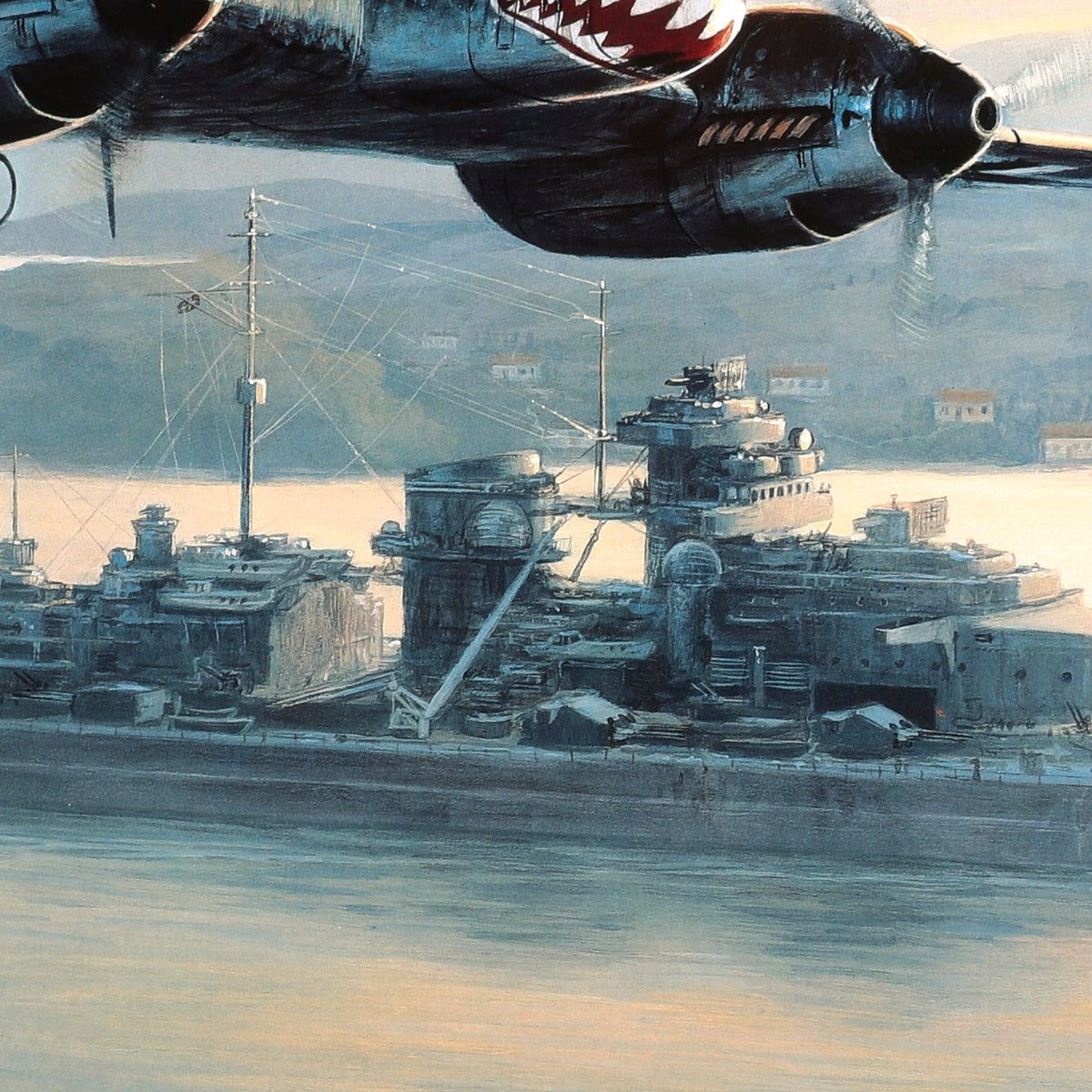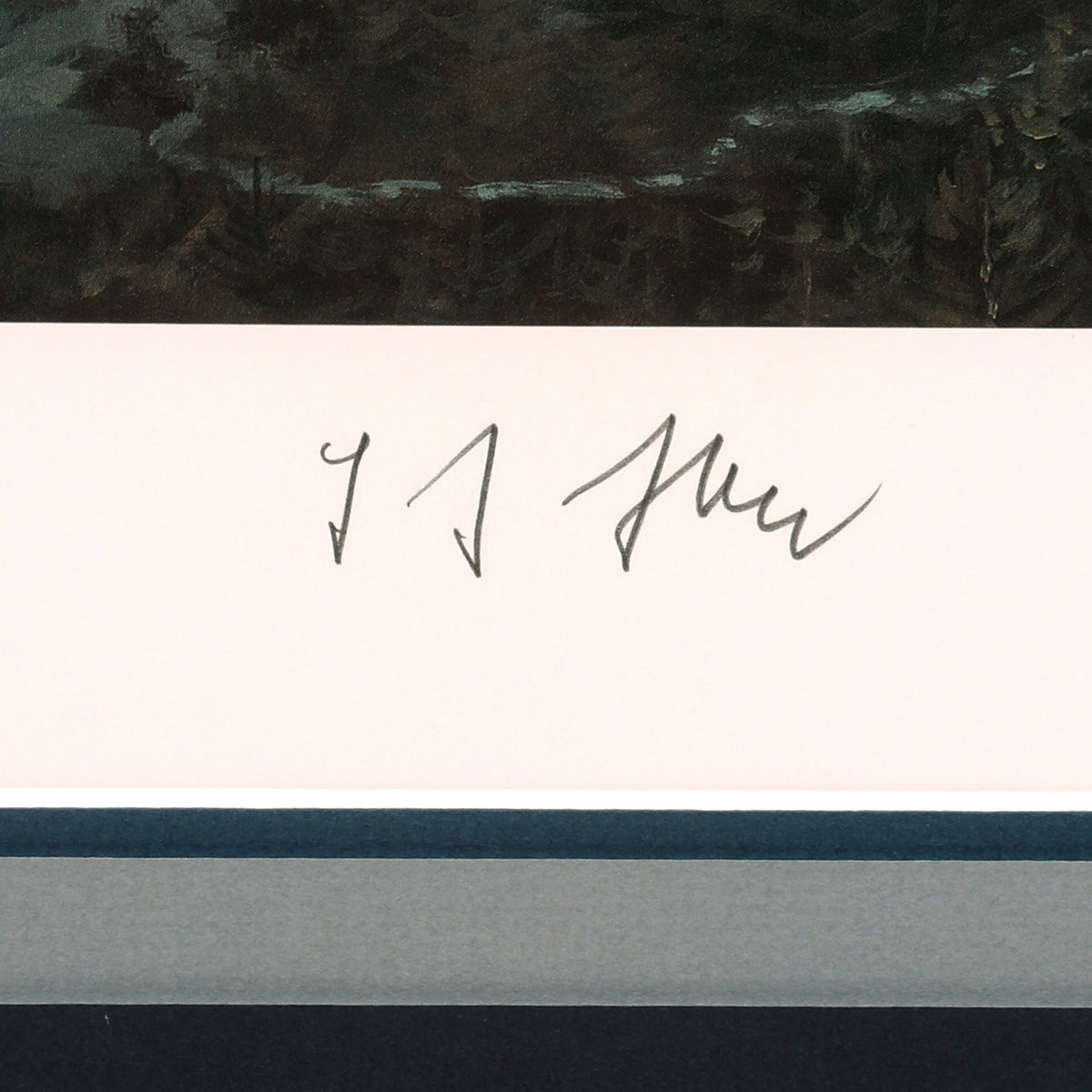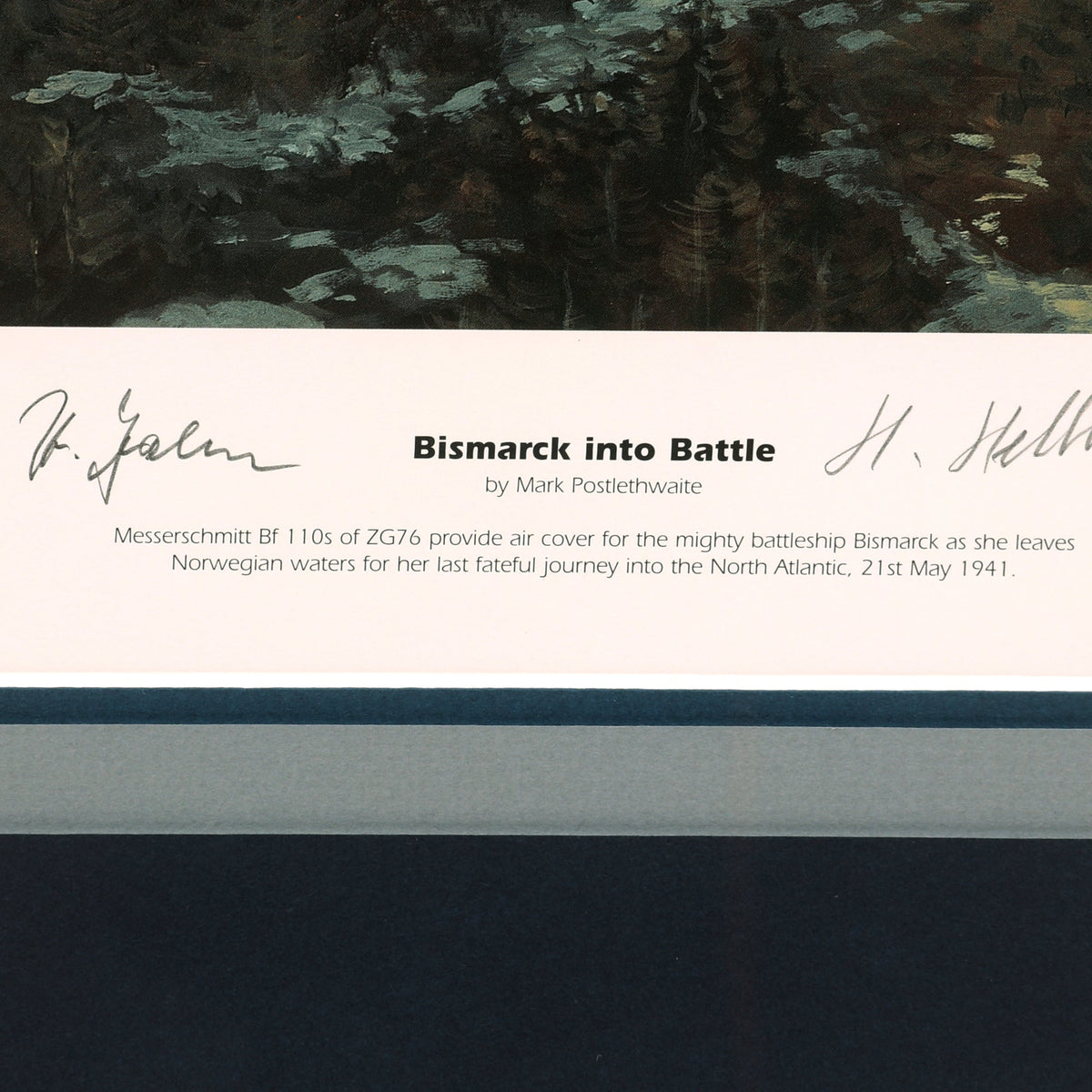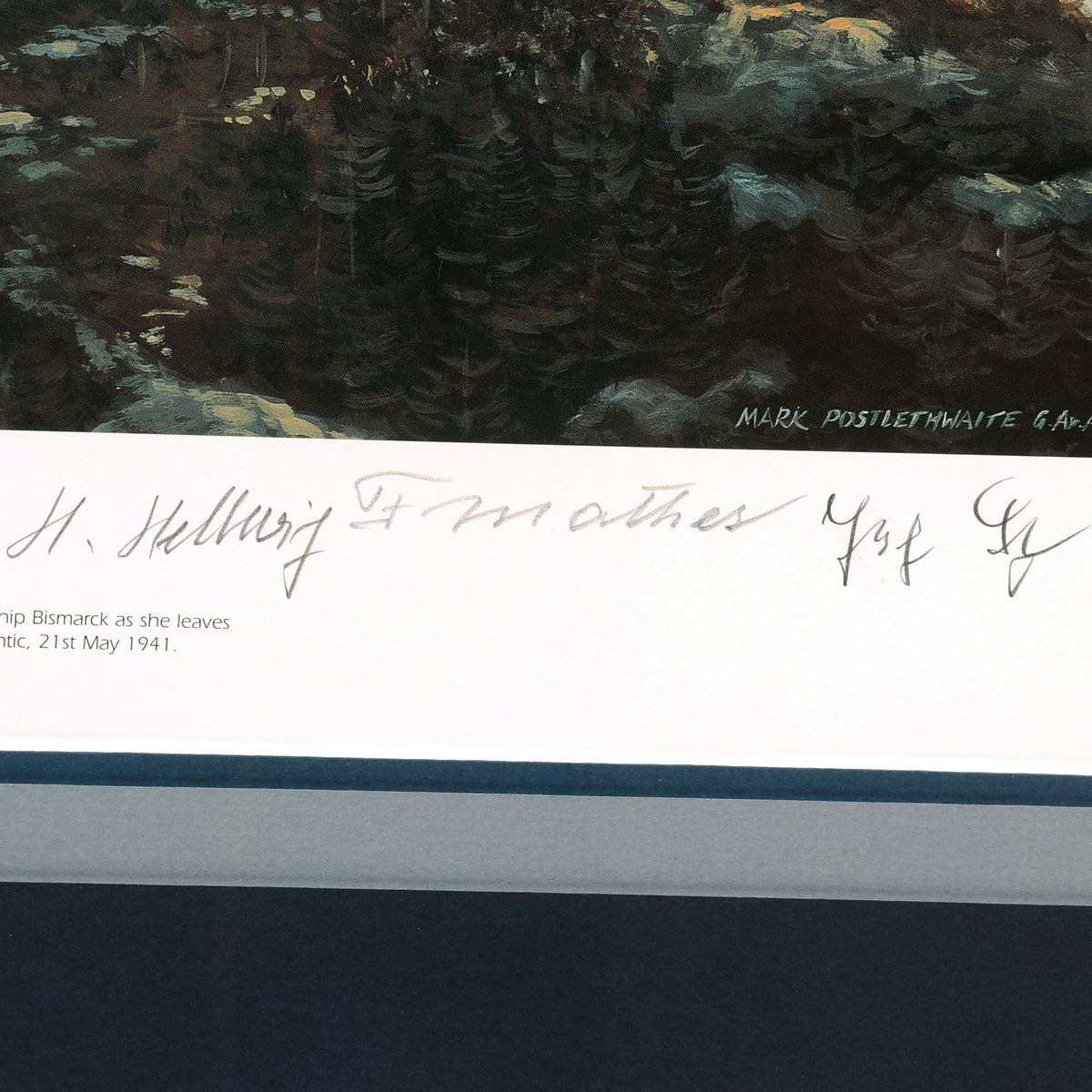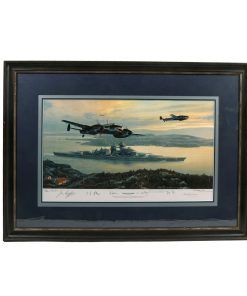Original Artist’s Proof Print: “Bismarck into Battle” Painting Leaving Grimstadfjord in Norway; Signed by Artist, Me110 Pilot, 4 Bismarck Survivors, and 2 RAF Swordfish Pilots – 35 ½” x 25″, in Museum Grade Frame Original Items
$ 1.095,00 $ 273,75
Original Item: Only One Available. This is a fantastic framed ARTIST’S PROOF print of Mark Postlethwaite’s painting Bismarck into Battle, matted and put into a museum grade frame measuring 35 ½” x 25″. This is number 12 of only 20 Artists Proofs made during this run, compared to 850 standard prints, all of which were made available for collectors. This will make a fantastic display piece on any wall!
The painting shows the German WWII battleship Bismarck as she leaves Grimstadfjord in Norway, being is escorted by Messerschmitt Bf-110’s of II/ZG 76 based at nearby Herdla. The time is 19:45 hours on 21 May 1941 and the scene is one of tranquility before the battle commences.
Three days later she would meet British forces during the Battle of the Denmark Strait. During this engagement the British battlecruiser HMS Hood, the pride of the Royal Navy, took a hit to her magazine, which exploded, breaking the ship in half. This resulted in the loss of all but three of her crew of 1,419, a massive loss to the Royal Navy.
Outraged at the grievous loss Winston Churchill signaled the Admiralty just three words: “Sink the Bismarck!” Thus began one of the epic sea chases in the history of naval warfare. What followed was a mobilization of virtually every Royal Navy asset in the vicinity to the end of that singular goal. The Bismarck had sustained damage during the battle, but not enough to seriously slow her down. With U-boats and other German vessels being deployed to help the Bismarck escape, it was a race to find the ship before she could meet up with escorts or find a safe harbor. Many of the British ships were also running low on fuel, and refueling would mean breaking off pursuit. As she was faster than most of the ships pursuing her, the best way to find the ship was to spot her by air.
Eventually a Consolidated Catalina flying boat from No. 209 Squadron RAF was able to locate the Bismarck an signal her location to the British Admiralty. The only way to prevent the Bismarck escaping was to slow her down, which was accomplished by a Fairey Swordfish torpedo bomber from the aircraft carrier HMS Ark Royal. One was able to land a hit on the Bismarck’s port rudder shaft, which made the Bismarck unable to steer. With the battleship now stuck going in circles, it was relatively easy prey for the Royal Navy, who proceeded to shower it with a massive amount of shells and torpedoes, achieving revenge for the loss of the Hood. Thus ended what was arguably the most legendary Battleship engagement of WWII, which is one of the reasons why it continues to captivate us, all these years later.
The print itself has a short description printed below, which reads:
Bismarck into Battle
by
Mark Postlethwaite
Messerschmitt Bf 110s of ZG76 provide air cover for the mighty battleship Bismarck as she leaves Norwegian waters for her last fateful journey into the North Atlantic. 21st May 1941.
Additionally, the print is signed by artist Mark Postlethwaite on the far right, along with one Me110 Pilot and four of the small band of only 110 crew members who survived the sinking of the Bismarck:
Hans-Joachim Jabs – a Knight’s Cross with Oak leaves holder, Jabs began his military career in 1936 serving with JG344 which later became ZG76. An accomplished pilot who spent most of his career flying the Messerschmitt 110, he became Kommodore of NJG1 in March 1944 and ended the war with 50 victories.
Hans Hellwig – enlisted in 1940 as a machinist/fitter and served on the Bismarck in Division III maintaining the Caesar Gun Turret as well as the port side 15 and 10 cm guns. After the Bismarck was sunk, he was rescued from the water by HMS Dorsetshire.
Herbert Jahn – joined up in 1939 as an engineer. Served on the Bismarck in Division XII maintaining turbines. He was wounded during the sinking of Bismarck and was rescued from the water by HMS Dorsetshire.
Fritz Mathes – enlisted in 1935 and served on the Admiral Scheer, winning the German Spanish Cross in Bronze with Swords during a Spanish engagement in May 1937. He was transferred to the Bismarck as Corporal in charge of Optical rangefinding. After the sinking of Bismarck he was rescued by HMS Maori.
Josef Statz – Joined the Kriegsmarine in 1940 as a technician. He served on the Bismarck in Division XII in the ship’s Control Room reporting to the First Officer. He was rescued after the sinking by HMS Dorsetshire and went on to write the book ‘Schlachtschiff Bismarck’.
Additionally, it is also signed by two of the Fairey Swordfish pilots who flew from Ark Royal to attack the Bismarck, directly leading to her sinking:
Sean Dixon-Child – Lieutenant Commander Dixon-Child was a pilot with the Royal Navy Fleet Air Arm, he flew Swordfish 5B on 26th May 1941 off Ark Royal in a strike against the Bismarck. The 15 Swordfish in this particular strike were credited with 2 confirmed hits and one probable. These hits were directly responsible for the sequence of events which ultimately led to the sinking of the Bismarck.
John Moffat – Lieutenant Commander Moffat was a pilot with the Royal Navy Fleet Air Arm, he joined the RNVR at the outbreak of WW2. After flying with various squadrons, he flew Swordfish 5C on 26th May 1941 off Ark Royal in the same strike as Lt. Cdr. Dixon-Child, also contributing to the sinking of the Bismarck.
A great display item, one of only twenty made, ready for further research and display!
Fast Shipping with Professional Packaging
Thanks to our longstanding association with UPS FedEx DHL, and other major international carriers, we are able to provide a range of shipping options. Our warehouse staff is expertly trained and will wrap your products according to our exact and precise specifications. Prior to shipping, your goods will be thoroughly examined and securely secured. We ship to thousands clients each day across multiple countries. This shows how we're dedicated to be the largest retailer on the internet. Warehouses and distribution centres can be located throughout Europe as well as the USA.
Note: Orders with more than one item will be assigned a processing date depending on the item.
Before shipping before shipping, we'll conduct a thorough inspection of the items you have ordered. Today, the majority of orders will be delivered within 48 hours. The delivery time will be between 3-7 days.
Returns
The stock is dynamic and we cannot completely manage it because multiple stakeholders are involved, including our factory and warehouse. So the actual stock may alter at any time. It's possible that you may not receive your order once the order has been made.
Our policy is valid for a period of 30 days. If you don't receive the product within 30 days, we are not able to issue a refund or an exchange.
You can only return an item if it is unused and in the same state as the day you received it. You must have the item in its original packaging.
Related products
Uncategorized
Uncategorized
Uncategorized
Australian WWII Owen MK1 Machine Carbine SMG Custom Fabricated Replica with Sling Original Items
Uncategorized
Uncategorized
Uncategorized
Uncategorized
Uncategorized
Uncategorized
Uncategorized
Uncategorized
Uncategorized
Uncategorized
Uncategorized
Uncategorized
Uncategorized
Uncategorized
Angolan Rebel 1970s era 60mm Inert Display Mortar from Angolan Civil War Original Items
Uncategorized
Armored Burgonet Helmet & Polearm from Scottish Castle Leith Hall Circa 1700 Original Items
Uncategorized
Band of Brothers ORIGINAL GERMAN WWII Le. F.H. 18 10.5cm ARTILLERY PIECE Original Items

